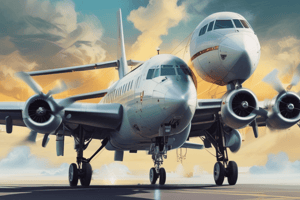Podcast
Questions and Answers
What should the pilot flying do before the pilot monitoring sets the A/SKID switch to OFF?
What should the pilot flying do before the pilot monitoring sets the A/SKID switch to OFF?
- Press the brake pedals continuously
- Activate the parking brake
- Release the brake pedals (correct)
- Increase reverse thrust immediately
What is the maximum brake pressure that should be monitored when using alternate braking?
What is the maximum brake pressure that should be monitored when using alternate braking?
- 500 PSI
- 750 PSI
- 1500 PSI
- 1000 PSI (correct)
If there is no braking after activating alternate braking, what action should be taken next?
If there is no braking after activating alternate braking, what action should be taken next?
- Use full reverse thrust until stopped
- Increase brake pressure to maximum immediately
- Set A/SKID back to ON
- Apply the parking brake in short successive applications (correct)
What is the purpose of setting the A/SKID & N/W STRG switches to OFF?
What is the purpose of setting the A/SKID & N/W STRG switches to OFF?
What should the flight crew monitor while operating under the alternate braking mode?
What should the flight crew monitor while operating under the alternate braking mode?
Flashcards
Loss of Braking, Initial Action
Loss of Braking, Initial Action
If braking fails, the crew may use maximum reverse thrust to stop the aircraft completely.
Alternative Brake Mode
Alternative Brake Mode
Switching A/SKID & N/W STRG to OFF activates a secondary braking system.
Alternate Braking Precautions
Alternate Braking Precautions
Release brake pedals before the PM disables A/SKID to prevent harsh brake application.
Emergency Braking Procedure
Emergency Braking Procedure
Signup and view all the flashcards
Brake Pressure Limit (A/SKID)
Brake Pressure Limit (A/SKID)
Signup and view all the flashcards
Study Notes
If no braking:
- If needed, flight crew maintains maximum reverse thrust until aircraft stops.
Brake Pedals:
- When the flight crew activates anti-skid braking, the alternate braking mode is engaged.
- The pilot flying (PF) releases the brake pedals before the pilot monitoring (PM) disengages the anti-skid system (A/SKID).
- This action avoids harsh braking.
- For the alternate braking mode, refer to the Alternate Braking section.
A/SKID OFF:
- The pilot flying (PF) commands the pilot monitoring (PM) to turn off the A/SKID and N/W STRG systems.
A/SKID & N/W STRG:
- A/SKID and N/W STRG are switched off.
Brake Pedals:
- Brake pedals are pressed.
Max Brake Pressure:
- Limit brake pressure to approximately 1000 PSI.
- Monitor brake pressure on the BRAKES PRESS indicator.
If still no braking:
- Apply the parking brake in short, successive applications to stop the aircraft.
- For more details on parking brakes, refer to the Parking Brake section.
Studying That Suits You
Use AI to generate personalized quizzes and flashcards to suit your learning preferences.



